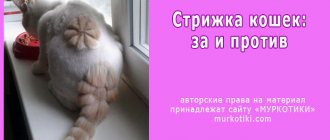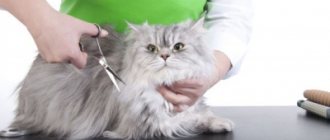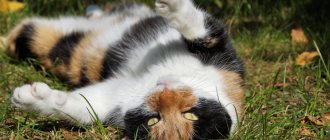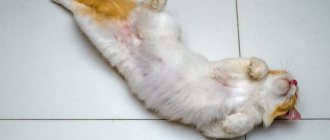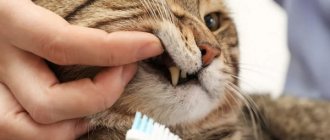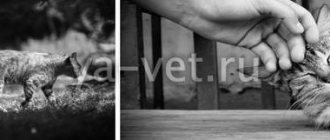Grooming a cat yourself is a responsible undertaking and should be approached with extreme caution. Grooming only makes sense if the cat is long-haired and in the summer, when it is hot. Or if a lot of mats have accumulated. Semi-longhaired, and especially shorthaired, cats do not need to be trimmed. This is unnecessary stress for them. We also do not recommend cutting an animal’s hair for “decorative” purposes, turning it into a lion or dragon simply for the sake of beauty.
How often to cut, including depending on the breed
The frequency of haircuts depends on the rate of hair growth, the age of the cat, and its health. It is recommended to cut your hair 2-3 times a year, not more often.
| Cause | Explanation |
| Hygiene | Long-haired cats get dirty very quickly, their fur rolls into lumps, and when licking, the likelihood of swallowing it is high, which can lead to problems with the digestive tract. |
| Shedding | Reducing the amount of wool on furniture. |
| Skin diseases (infections, parasites, hyperplasia of the sebaceous glands, dermatitis) | With short hair, a cat is easier to handle. |
| Exclusive view | Only for the purpose of participating in exhibitions. |
For Persians, a haircut is an ideal option, especially in the summer, as they quickly grow overgrown, and they also do not like heat.
What breeds of cats are prohibited from being cut?
- Shorthair (British, Scottish Fold). There is no particular point, only when absolutely necessary. Please note that there are long-haired types of these cats, namely British Longhair and Highland Fold, they need to be cut.
- With tipping or color-point color. After a haircut, the pet's color changes (becomes darker).
- Semi-long-haired breeds (Siberian and Norwegian forest cats, Maine Coon) do not need a haircut; you can only limit yourself to bathing and thorough combing. Their fur serves as an excellent protector from overheating and freezing. Also read how to properly bathe a cat and how to brush it on the Mister Cat portal.
In addition, you should not generally trim hyperactive pets, which are difficult to pacify and require the use of sedatives, which have a negative effect later.
What to do if you accidentally hurt your cat?
Sometimes even the most careful actions can lead to injury. What to do if the cat is still injured? You should have iodine or hydrogen peroxide with cotton swabs on hand. Apply a small amount of antiseptic solution to cotton wool and gently rub the skin around the cut to stop bleeding, you can press a dry cotton swab against the wound for a few minutes.
Please note: in such an unpleasant situation, you should not panic. It is advisable to calm the animal by telling it in a quiet voice the kind words that you are used to saying in a normal situation. While grooming, you should under no circumstances raise your voice to the cat or speak in a raised voice with your partner, make sudden movements, and especially not use physical force (we are talking about hitting, pinching and other actions).
Thus, grooming a cat at home using clippers and scissors is, first of all, a hygienic event aimed at maintaining a neat appearance of the pet. If you are going to prepare your cat for a show or other important event, it is recommended to schedule a decorative haircut with a professional groomer. In clinics, decorative haircuts for cats are done using light anesthesia or sedatives. However, it should be remembered that constant exposure to such medications can adversely affect the health of your pet.
How to cut a cat's hair: types of haircuts
| Type of haircut | Description |
| Exhibition (Harlequin, Continental, Modern)
| Emphasizes the extravagance of the animal. |
| The Dragon | On the back and tail, scraps of fur are left in the form of small triangles that form a mohawk (the shape can be different). The head and limbs are not cut. |
| French lion | Used both for hygiene purposes and as a model. Great for summer. They cut off everything on the body, leaving the head intact, a small tassel at the tip of the tail, and the part below the knees on the paws. |
| Puss in Boots | They expose the entire body, bypassing the head, tail and paws. |
How to choose
When choosing the right tool, you should consider several points:
- animal size;
- coat length and texture;
- haircut goals.
So, for a general Maine Coon haircut, you need to choose scissors with a longer cutting blade than for a Highland haircut. But for an owner who has no experience in cutting hair, it will not be comfortable to work with long scissors, so it is recommended to choose a medium size blade.
To create rounded shapes on the face and paws, short scissors with rounded ends are suitable, as are small thinning scissors.
Scissors for cutting tangles come only short.
Before purchasing, the owner is recommended to hold the instrument in his hand to evaluate the comfort.
Choosing Cat Grooming Tools
The haircut can be carried out using scissors (medium size, sharp with rounded ends) or a clipper, preferably silent, so as not to frighten the pet. The latter method is more effective and safer - there is practically no possibility of injuring the animal, and the result is guaranteed: a uniform haircut with the ability to choose the desired length of fur.
Auxiliary tools:
- soft comb;
- textile;
- hydrogen peroxide or chlorhexidine (needed if you injure an animal);
- toys and treats;
- table (or other surface).
It is better to immobilize the cat during the procedure. For example, wear a special collar. It is better for the second person to hold the cat and calm it while the first haircut is performed.
If the animal is very aggressive, it is better to visit a veterinary clinic. In some cases, anesthesia may be needed. It is worth doing it only if there is no other option. For example, a cat is covered in tangles and it’s hard for him.
The process of cutting a cat with scissors
To groom a cat at home, it is important to have someone help hold it for the first time. The cat is placed on its side and its limbs are supported. You can use a plastic collar for safety.
Before the procedure, it is important to disinfect the instrument with alcohol so as not to infect the animal in case of injury.
Using scissors, you should immediately cut off tangles and any areas of matted fur. Then proceed directly to the haircut:
- The head is treated. Usually the head is not cut bald, leaving a fluffy hairstyle, but it is better to immediately trim off the excess overgrown strands and hair. It is important not to touch the whiskers, but it is better to remove the “whiskers” - it will be easier for the pet to eat and keep clean.
- Remove excess volume from the body, neck and behind the ears, paws and tail.
- Pay special attention to the intimate area; it is important not to damage these areas with scissors.
After finishing, you should wash the cat and dry it thoroughly with a hairdryer, removing excess hair.
Preparing for a haircut
The preparatory steps are as follows:
- Examine the cat. If there are skin lesions, it is recommended to reschedule the haircut. However, you don’t have to do this; then the wounded area needs to be carefully trimmed so that the wound is visible.
- Wash your pet.
- Decide on a tool. It should be well pointed.
- Choose the right time. The best thing is a period of rest, since while the cat is awake, it can injure both itself and the person.
Selecting tools is a good start
Almost anyone can cut a cat's hair, as long as it is comfortable for the owner and not scary for the pet. Additionally, different types of haircuts require different tools.
If you decide to become a professional groomer at home, it is better to immediately stock up on everything you need. These will be:
- sharp scissors (small and medium in size);
- an ordinary clipper (it is practically harmless, but can scare the animal with its buzzing);
- trimmer with small blades (for processing hard-to-reach places);
- a comb with soft teeth (so that the cat does not feel discomfort);
- hydrogen peroxide (in case of injury);
- scissors with rounded tips;
- unnecessary fabric (towel) for bedding;
- a soft toy - so that the cat is periodically distracted from the process that frightens it.
You also need to determine in advance the place - a smooth horizontal surface - where the cat will sit during the procedure. The pet should not feel fear, and the owner should be able to work comfortably and lightly. During the haircut, ensure a quiet atmosphere so that the pet does not jump from a sudden knock or click - any careless movement can cause injury.
Mr. Cat recommends: step-by-step instructions for grooming a cat
- Prepare all necessary tools and disinfect them.
- Trim the nails with a nail clipper or using regular nail scissors. Take the animal's paw, press on the pad and trim the claw. Read the article about how to choose a nail clipper for a cat, what they are like and how much they cost.
- Immobilize your pet by placing it on its side and holding its paws.
- In case of aggressive behavior, wear a special plastic collar.
- Immediately cut the fur from the sides, then from the back and belly. Take special care in the nipple area.
- The skin should be taut to avoid injury. It is better to remove tangles with scissors, preferably before cutting or as you find them.
- You can cut both against hair growth and along.
- At the end of the work, the cat should be wiped with a damp cloth.
Why cut your cat's hair?
The main purpose of grooming animals is to care for their fur.
Cats have a natural need to constantly care for their fur coat. But very often this is not enough, especially for fluffies with a fur length of more than 3 cm. Special care is recommended for such pets, including regular combing, removing tangles and trimming excess hair.
Cat trimming procedure
The cat trimming procedure consists of the following steps:
- It is necessary to fix the pet in a position lying on its side, holding it by the hind and front legs.
- First of all, the tangles are cut off with scissors. After this, they continue cutting the hair on the sides of the body and back using a clipper.
- When trimming fur from the belly, you should carefully avoid the nipples and intimate areas. Experts recommend first cutting the hair in intimate areas with scissors and then completing the manipulation with a clipper. It must be remembered that cats' skin is very thin and easily injured. Therefore, while working with the machine, you need to tighten it so that skin folds do not get under the blades.
- At the end of the procedure, the cover on the paws is cut off.
- The hair on the animal's head is not trimmed; it is possible to shape it with thinning scissors. It is strictly forbidden to trim the mustache, as it is an important organ of touch.
- Tail trimming is carried out at the request of the owner.
If you can’t cut your cat’s hair in one procedure, you can divide it into several stages. This will allow the pet to avoid unnecessary stress, and the master from bites and scratches.
After grooming, the animal must be bathed and dried with a hairdryer. If your cat is afraid, you can remove cut and stuck hairs by wiping it with a damp cloth or chamois cloth. During the cold season, you should create a comfortable microclimate without drafts in the room where the pet is.
After the haircut
As we have already said, after grooming the cat should be wiped with a damp cloth, and it is also worth combing it. As a rule, cats easily get used to their trimmed appearance. But some problems may arise:
- The cat may get injured when scratching or playing the first time after the haircut.
- May begin to lick itself more often and exhibit slight irritation.
- In rare cases, the behavior may change and aggression may appear: the cat damages furniture, defecates in inappropriate places, or attacks.
If the cat’s behavior does not return to normal on its own, then you need to contact a veterinarian.
Instrument care
Thanks to the use of high-quality materials, professional line scissors do not require special care.
However, general rules for maintaining metal tools should be followed.
- Scissors should be stored horizontally. The ideal place for storage would be a special case, lined inside with suede or soft fabric.
- Before starting work, you need to check the tension of the sheath if the screw is adjustable.
- After use, scissors (but not cutting blades) should be wiped with a piece of soft cloth using a small amount of oil (special).
- Shearing scissors should only be used for cutting wool, and not for cutting flowers, paper or other materials.
Silent Scaredy Cut scissors do not require special care. They were originally designed for home use, so maintenance is kept to a minimum. Stuck hairs can be brushed off with a brush or rinsed under running water, then wipe the instrument dry.
Some manufacturing companies stipulate that the blades of their products do not become dull for a long time. But if the question of sharpening still arises, you need to contact a specialist. You should not try to sharpen the tool with improvised means, as this may render the scissors unusable.
How often do you need cat ear care, and what lotions, drops and other products are used at home?
Positive points
- Yes, a haircut makes life easier for a long-haired pet: it is easier for a cat to lick itself and wash its coat. In this case, the animal will not clog its stomach with swallowed wool.
- This means that hair removal paste is not needed and the family budget will not suffer.
- In summer, the animal suffers less from the heat, and in the winter months, apartment heating will warm the cat, no matter how short its hair is cut. The main thing is that there are no drafts in the rooms.
- The absence of fur on most of the purr's body gives owners rest. There is no need to comb your pet or fight fluffy debris in the apartment. After all, before the haircut, cat fluff flew around the house like poplar.
- No wool - no allergies. This is also an important aspect of the issue, especially for family allergy sufferers. You can safely continue to communicate with your four-legged family pet.
Is it possible to cut a cat's hair with a clipper?
Any pet loves when its owner spares no time to carry out various care procedures. This becomes especially true for cats with long and thick hair. If you do not pay attention to this problem in time, then the animal’s fur can become matted and it becomes very difficult to untangle it. Each owner of a furry friend is looking for his own way to help correct the situation. For example, some suggest using clippers to keep cats' fur in good order.
If your cat has a calm character and is not afraid of the upcoming haircut, then you can use a beauty machine, not forgetting some tips.
Causes and consequences of using inappropriate equipment
Working as a hairdresser, a close acquaintance with such a specialist, or a desire to try out a purchase – various factors lead to the decision to cut a cat’s hair with a clipper for a person. Human equipment is not designed for wool. Low-power (about 10 W) models will slip. If the device takes cat hair, problems arise in the form of:
- pain in the pet;
his discomfort due to loud noise;
overheating of equipment due to increased load.
It is better to cut the animal with special devices. In comparison with hairdressing equipment, they are characterized by:
frequent equipping with batteries for wireless operation;
comparatively cheap relative to power - a Chinese 35 W machine can be bought for about 900-1000 rubles.
If human equipment is the only way to cut a cat’s hair with a clipper, you need to find out the power and noise level of the device. It is better to use machines with parameters from 20 W and about 60 dB. If a choice is possible, each device is tested on fur, observing the efficiency of operation and the reaction of the animal.
The machine should not slip and start making a strained buzz, the cat should show more anxiety than when using veterinary hairdressing tools.
Timing your haircut
Cats may be in heat. The desire for attention from the owner makes the female more accommodating. This solution is not suitable for cats due to increased aggressiveness during the search for a partner. If you do not rely on sexual phases, haircuts should be carried out when the pet is calm and resting after playing.
To treat your pet you need:
- Prepare the client. It is worth introducing your cat to the tools in advance so that she gets used to the sound of the machine.
Find a partner. It is better to involve a person whom the animal knows and loves. Grooming a cat is stressful for your pet, and you shouldn’t aggravate it with contact with a stranger. Many hide or show aggression.
Choose a location. It is better to work on tiles or linoleum. If there are no such surfaces, you can lay easy-to-clean material on your pet’s favorite resting place. A smooth fabric like rayon won't deter your cat, but will help clean up fur.
Comb your pet. Excess hair and dirt are removed. The pile is unraveled and the animal, who loves the procedure, is further relaxed.
Calm the animal. You need to pet your pet and let him get used to the presence of two people. When you hear the purring, you can start cutting.
Guide the machine. It's better to work on wool. Moving against the pile increases the risk of scratching or pulling out several hairs, causing pain to your pet. You should not trim your paws in the area of the pads. Treatment of the genitals is acceptable, but must be done carefully. So, it is better to use a 1 cm nozzle.
In the process, one person operates the machine, the other holds the pet and, if necessary, stretches the skin. The choice of haircut depends on the wishes of the owner. So, he can limit himself to treating the belly and the area under the tail - partial removal of lint here helps in caring for long-haired and plump individuals.
To prepare for summer, grooming a cat with a human clipper can be done with a smaller (1 cm) attachment. The animal sheds less, but does not lose its natural protection from temperature changes and injuries. Cutting your hair too short can lead to ingrown hairs and irritation. The latter occurs both due to contact with the machine and during licking.
Care after the haircut procedure
It is advisable to bathe the cat to remove excess lint and fat. Animal shampoo is used for this. If your pet does not like water treatments, you can limit yourself to wiping with a damp towel. When using clippers for people, it is worth inspecting the treated areas for scratches and irritation. Cats can widen wounds by scratching and cause infection.
If you have short hair, you should use veterinary sunscreen. They are especially relevant for animals that spend a lot of time outside and on open balconies. The products protect against sunburn and prevent the development of skin cancer - in particular, squamous cell carcinoma.
They are recommended for sphinxes and pets with light skin (fur). Sunscreen products that meet human protection levels of SPF 15 or SPF 30 and cropped individuals are suitable.
Cats' fur grows back slowly. If the pet is not being prepared for exhibitions, one haircut is enough for six months. The machine can be used to process other animals or people. Veterinary equipment is also suitable for humans. Such devices are preferable due to their compactness, battery life and lower noise levels.
You just need to clean the blades before use and lubricate the parts according to the instructions. If your pet is infested with fleas (other parasites), it is best not to use clippers on other pets.
Washing equipment is contraindicated, and disinfection with alcohol does not kill all parasites. Other antiseptics may damage the mechanism.
You should not cut your cat's hair with a human clipper. The device will get stuck in the fur, scaring the pet with a strained hum and pulling out the fur. There is also a risk of the unit stripping - the motor will not withstand excessive load. Professional hairdressing equipment can deal with lint, but it is better to buy veterinary equipment. It is more compact and quieter.
It is advisable to groom a cat together - the pet is first prepared for the procedure and calmed down. After the procedure, it is advisable to wash it or wipe it with a damp towel. With a short haircut, it is worth limiting the animal’s contact with direct sunlight.
Do you groom your pet? Write in the comments.
Note to the master
Some more useful tips for grooming cats:
- You can’t cut your hair with just a clipper or just with scissors: it will be ugly and sloppy. These tools should be alternated wisely.
- The main coat is cut with a clipper. What remains is trimmed with scissors.
- Clippers require dry hair.
- Before trimming the fur with scissors, it must be moistened with water and combed.
- You cannot shave your animal bald; always leave at least 2 mm of fur. This will maintain normal thermoregulation and reduce the risk of injury.
